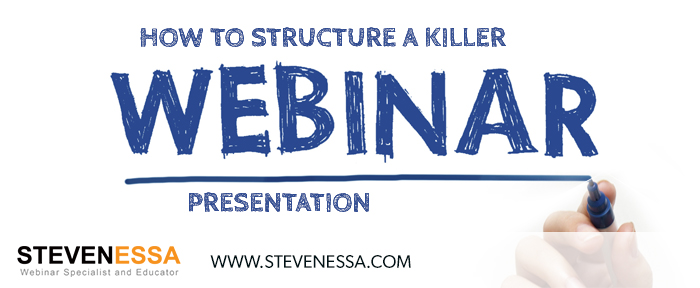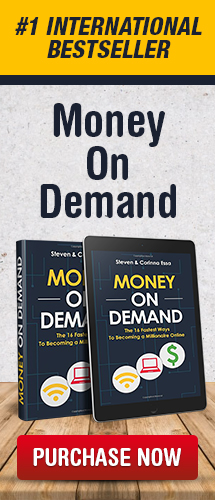After watching hundreds of webinar presentations, I have noticed that when they are not structured in a certain way, and don’t flow well, the audience gets easily confused and lost. This is why it is important to structure your webinar presentation in the format below:
Introduction of your webinar
The first slide of your webinar presentation should simply be the title of your webinar. The title should be catchy, and is also known as a “marketing hook.”
It’s important for your marketing hook to grab the attention of your target audience by giving them a big promise while keeping an element of surprise.
Remember, the title will make or break the attendance rate of your webinar.
Here are examples of marketing hooks or webinar titles:
- Attention natural health practitioners: How to double your client base for free, thanks to the internet
- The little-known secrets to be back-pain-free naturally in 30 days
- The 7 natural remedies for arthritis
- Attention career women: 5 steps to getting the man of your dreams
- How to look 20 years younger naturally
The next step of your introduction should identify the webinar’s intended audience.
For example, imagine you’re presenting a webinar on weight loss, titled How to lose up to 5 pounds in 30 days and keep it off for good. It’s important you state specifically who the webinar is for.
Based on the title, you might think the answer is obvious, but reiterating in more detail who the webinar is for, enables the viewers to identify themselves. The more you describe your target audience in detail and touch on their pain and challenges, the more they’ll feel understood. This will impact sales considerably.
You should say something like,
“This webinar is for you if you’re a woman over 40 who has tried different diets over the years but as soon as you lose weight, you put it on again.”
Or,
“This webinar is for you if you’d like to lose weight but don’t have time to hit the gym.”
This is important because you want as many people as possible to say to themselves,
“Great! This is for me, that’s what I’ve been looking for.”
Or,
“Yes that’s how I’ve been feeling, yes I hate the gym!”
Then, your introduction should also describe who you are and why you’re sharing this information.
“Why should I listen to you?” is a very common question webinar audience members subconsciously or consciously ask themselves and it’s important that you answer it in the first ten or fifteen minutes of the webinar. Include as much evidence as you can that you have experience in the topic you’re covering. Show how you’ve achieved significant results yourself as a result of implementing the strategy that is about to be revealed in your webinar. This will establish that much-needed trust. And trust is a vital component for closing sales. As I always say, “nothing sells more than proof.”
Then, explain why the audience will benefit from watching your webinar in its entirety.
To ensure your audience stays engaged throughout the whole presentation, make sure you whet their appetite with what’s about to come. For example, don’t give everything away by saying,
“I’ll show you that eating six small meals a day will make you lose weight fast without ever feeling hungry.” It’s best to keep a level of mystery by saying,
“I’ll reveal how you can eat more and still lose weight so you never feel hungry.”
Once you’ve completed the introduction of your webinar, run through it as if you were presenting it to a live audience to ensure it doesn’t exceed 15 minutes.
The content of your webinar
To make sure your webinar flows well, structure your content in three, five or seven steps.
When you do, the viewer should be taken from point A (not knowing anything or knowing very little about the topic) to point B (having a clear understanding of how they can achieve the results promised in the title).
For example, the structure of your presentation for “How to lose up to 5 pounds in 30 days and keep it off for good” could be:
Step 1: Set a goal and deadline
Step 2: Identify your bad eating habits
Step 3: Clear your fridge
Step 4: Prepare your weekly eating plan
Step 5: Keep a food diary
When putting together your content, try to include in each step a story or case study to illustrate each point made. For example, talk about how your client, “Lucy”, identified that one of her bad eating habits was skipping meals because she didn’t enjoy the meals provided at work. As soon as she realized that was making her store fat, she prepared her own lunch boxes and as a result lost five pounds in 30 days.
The more you include stories and case studies, the easier it will be for your audience to digest the information and remain engaged. Too often, presenters treat webinars as tutorials or lectures, which is the fastest way to lose your audience’s interest!
Your webinar close
To transition smoothly from the content to the selling section of your webinar, it’s important to announce you’re about to offer an opportunity for people to go further faster. A smooth transition could look like:
“If you’ve enjoyed this presentation and would like to learn more about how you can implement this strategy right now, I’ve put together a program called, The weight loss fast track formula.”
Alternatively, your transition could be, “I’ve delivered priceless information to you, right? But if you haven’t followed this system before, it could be a little overwhelming, right? Is it ok if I share with you how you can achieve your weight loss goals the fast and easy way?”
In the example above, you’re simply asking permission to introduce your offer. Notice that you’re asking a rhetorical question here and don’t need to wait for approval. Because you’ve delivered quality information and content prior to the pitch, the majority of your audience will naturally want to learn more about how to progress faster or achieve results quicker! Remember that you’re not selling them a product; you’re offering a solution to their problem and helping them achieve an outcome faster through your product.
The example I often use here to illustrate my point is the drill. People don’t buy a drill because they want a drill. What they want is a hole. They are buying the drill because they want to make that hole. With a weight loss product, they aren’t buying your product, they’re buying the body of their dreams.
One you’ve transitioned smoothly and listed the features and benefits of your offer, end your webinar with a strong call to action, inviting people to buy!



Thanks for the simple reminders on how to structure webinars